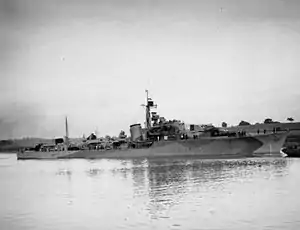HMS Hardy (R08)
HMS Hardy was a V-class destroyer of the Royal Navy that saw service during the Second World War.
 Hardy in August 1943 | |
| History | |
|---|---|
| Name: | HMS Hardy |
| Ordered: | 1 September 1941 |
| Builder: | John Brown & Company, Clydebank, Scotland |
| Laid down: | 14 May 1942 |
| Launched: | 18 March 1943 |
| Commissioned: | August 1943 |
| Identification: | Pennant number:R08 |
| Honours and awards: | Arctic 1943-44 |
| Fate: | Scuttled after being torpedoed on 30 January 1944 |
| General characteristics | |
| Class and type: | V-class destroyer |
| Displacement: |
|
| Length: | 363 ft (111 m) |
| Beam: | 35 ft 8 in (10.87 m) |
| Draught: | 10 ft (3.0 m) |
| Propulsion: |
|
| Speed: | 37 knots (43 mph; 69 km/h) |
| Range: | 4,860 nmi (9,000 km) at 29 kn (54 km/h) |
| Complement: | 180 (225 in flotilla leader) |
| Armament: |
|
History
Hardy was built by John Brown & Company, Clydebank, laid down on 14 May 1942, launched 18 March 1943, and completed 14 August 1943.
While escorting Convoy JW 56A during World War II, Hardy was torpedoed and damaged in the Arctic Ocean at 73°40′N 24°30′E by the German submarine U-278 on 30 January 1944 with the loss of 35 crew members. The British destroyer HMS Venus rescued her survivors and sank her.[1]
Notes
- "Naval Events, January–December 1944 (in outline only)". Naval History. Retrieved 29 December 2011.
References
See also
External links
- Hardy at naval-history.net
- Hardy at uboatnet
- http://www.russianarcticconvoymuseum.org/home/roberts-herbert-sydney
- http://www.russianarcticconvoymuseum.org/home/pearce-frederick
This article is issued from Wikipedia. The text is licensed under Creative Commons - Attribution - Sharealike. Additional terms may apply for the media files.